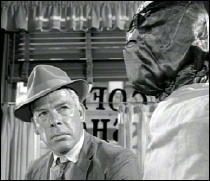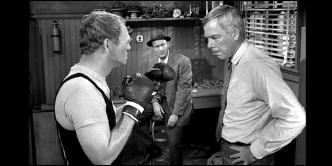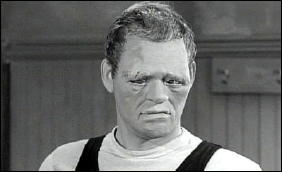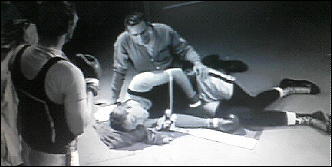Sun 27 Apr 2014
A TV Review by Jonathan Lewis: THE TWILIGHT ZONE “Steel” (1963).
Posted by Steve under Reviews , TV Science Fiction & Fantasy[4] Comments
“STEEL.” Episode of The Twilight Zone. CBS. Season 5, Episode 2. October 4, 1963. Lee Marvin, Joe Mantell, Tipp McClure. Director: Don Weis.

Stories set in a future that have long since passed are often particularly fascinating to read. They do not merely portray imagined futures. They also provide critical insight into how writers understood their own eras within the context of History’s tripartite realms of past, present, and future. Most significantly, many of these stories revolve around man’s complex relationship with technology.
Consider, for instance, George Orwell’s Nineteen Eighty-Four (1949), Nevil Shute’s On The Beach (published in 1958, but set in 1963), and Arthur C. Clarke’s, 2001: A Space Odyssey (1968). The years in which those novels are set have long since come and gone. When we read these novels, we are reading fiction set simultaneously in the future and in the past. True, they are works of fiction; the books’ authors did not intend them to be prescient renderings of what was yet to come.
Still, it’s worth reflecting on the fact that humanity did not usher into existence the most compelling aspects of these novelists’ imagined futures. More countries have democratically elected governments than ever before. Humanity avoided a nuclear holocaust. Man hasn’t traveled to Saturn. Scientists have not created an artificial intelligence nearly as advanced as HAL. Well, not yet, anyway.
Similar to the aforementioned novels, The Twilight Zone episode, “Steel,†based on a Richard Matheson story of the same name (published in the May 1956 issue of The Magazine of Fantasy and Science Fiction), also takes place in a future date that is now past.
Originally aired on October 4, 1963, “Steel†is set in a future 1974 in which human boxing is no longer permitted. Android-like robots are the only ones allowed to box; human boxing was criminalized in 1968. Rod Sterling’s narration provides context and instructs the viewer that such a law was passed in an attempt to abolish one facet of human cruelty:

The episode begins with Steel Kelly (Lee Marvin) and Pole (Joe Mantell) escorting a shrouded figure off a bus and into a small town diner. We soon learn that the mystery man accompanying them isn’t a man at all. Rather, he — it — is a fighting android answering to the name of Battling Maxo (Tipp McClure).
Steel Kelly and Pole are in need of some prize money. Maxo, a B2 unit and a heavyweight, is set to fight a more advanced B7 unit named Maynard Flash (Chuck Hicks). Problem is, Maxo experiences mechanical failure right before the big fight.
That’s when Steel Kelly, a former boxer, comes up with what he considers to be an ingenious plan. He’ll pretend that he’s Maxo and will go in the ring against Maynard Flash. Pole urges against this idea. Steel, portrayed with gusto by Lee Marvin, is not about to be swayed. He’s determined to see this through. All too human, Steel is both courageous and foolish. As one might guess, he doesn’t win the fight.

Sterling’s ending narration emphasizes that the main theme of the episode is man’s relationship with technology:
Upon hearing these words spoken and seeing Steel collapsed on the floor, I initially felt a sense of disappointment at how the episode ended. Lee Marvin was excellent, the androids appeared both plausibly human and uncannily creepy, and the writing was tight and without sentimentalism. But something was missing.
That’s when I realized that “Steel†is best appreciated within the context of stories set in the past, but which take place in the future, similar to the novels I alluded to previously.

In order to appreciate this particular Twilight Zone episode, one has to imagine oneself watching it when it was first aired, some two years after President Kennedy’s moon speech and two months after Martin Luther King Jr.’s “I Have a Dream Speech†in which he declared that, “1963 is not an end but a beginning.†Indeed, “Steel,†when considered within dual contexts of advancing technology and changing legal norms, packs more of a punch than when viewed without reference to contemporaneous political issues.
The episode’s theme of man’s relationship with technology, however, is a far more universal one. Ever since the Gothic horror of Mary Shelley’s Frankenstein (1818) and Victorian-era science fiction, the relationship between man and machine has been a constant theme in the genre. In this light, “Steel†isn’t a bad episode. It just seems as though it would have been a much better episode to watch and to ponder in 1963 than in 2014.
April 28th, 2014 at 5:40 pm
I seem to recall an anthology called Future’s Past or something like that. I agree it is an interesting portrait of a point in time.
Of course Hollywood only used the basic idea of mechanical fighters when they did this with Hugh Jackman not to mention adding a boy and his robot plot. Even then it is hard to smother Matheson’s original concept.
If you can get past the 1974 bit — the hazard of doing near future stories — I do think the episode still has something to say, less man vs machine than human will. Steel loses, but that he stood that long and fought that well is intended as a kind of triumph.
Science fiction has always had a strong humanistic streak that continues today.
April 29th, 2014 at 9:48 am
Marvin appeared in an earlier TWILIGHT ZONE that was a Western/horror story. What’s interesting is that the first part of that episode was set in a saloon and two of the cowboys there were played by Strother Martin and Lee Van Cleef who, around the same time, played Marvin’s henchmen in THE MAN WHO SHOT LIBERTY VALENCE.
By the way, BLADE RUNNER is set in 2019.
April 29th, 2014 at 9:57 am
Only five years to go! And how close to that future are we?
I remember seeing 2001: A SPACE ODYSSEY in a movie theater in Ann Arbor with my wife and another couple (maybe two other couples) when it came out in 1968 and thinking how unimaginably far away in the future 2001 was.
April 30th, 2014 at 6:09 am
I haven’t seen “Real Steel,” the movie with Hugh Jackman that is also based on the Matheson story. Maybe I will some time. I don’t think it was all that commercially successful